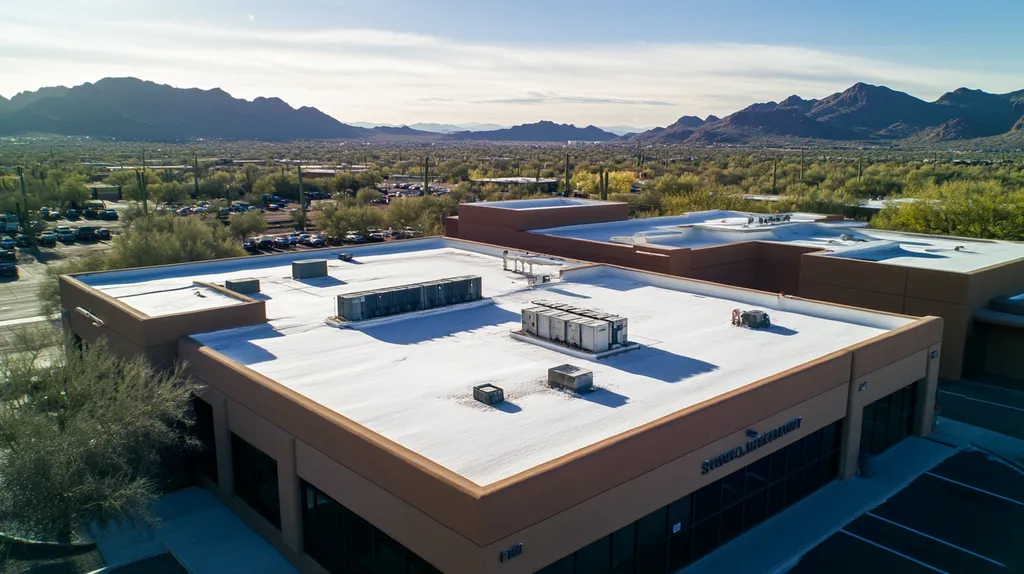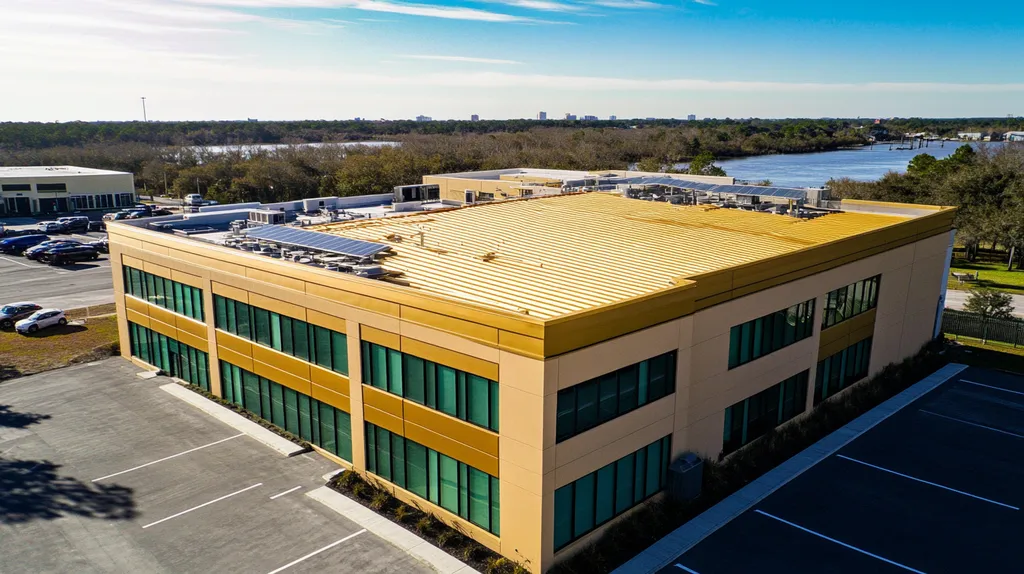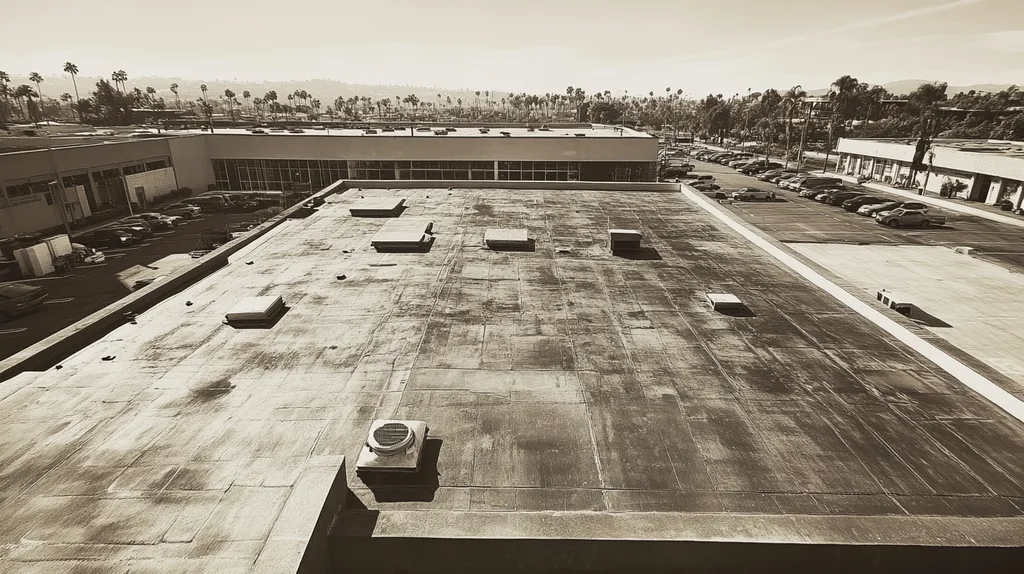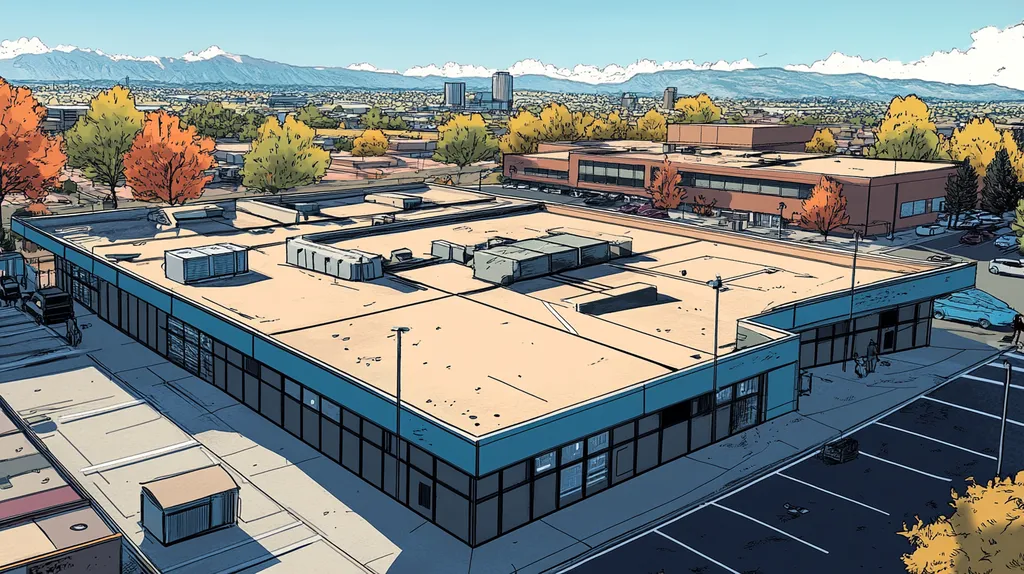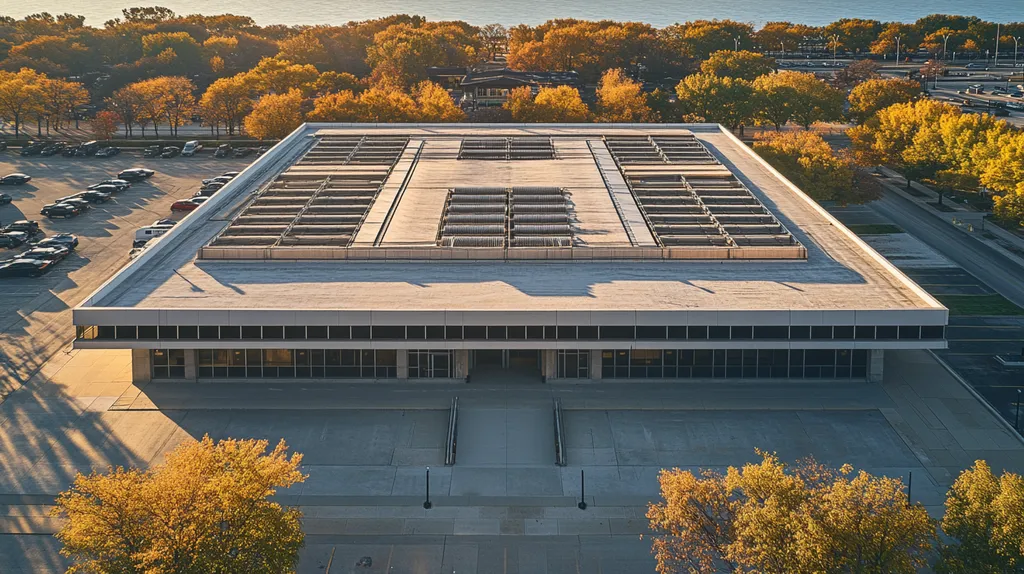The surge in industrial solar installations has created an urgent need for property owners to navigate complex permitting requirements. Recent studies show that over 60% of commercial solar projects face costly delays due to permit-related issues, resulting in millions in lost revenue annually.
Understanding the intricacies of solar permitting – from electrical compliance to structural requirements – is crucial for successful implementation. Without proper permits, facilities risk project shutdowns, hefty fines, and potential removal of installed systems.
This comprehensive guide examines the essential components of solar permitting, providing property owners and facility managers with actionable strategies to streamline approval processes while ensuring safety and regulatory compliance.
SECTION 1: FUNDAMENTAL CONCEPTS
As industries increasingly shift towards renewable energy, grasping the intricacies of solar permits for industrial roofs is more important than ever. These permits are essential for a smooth installation process, ensuring compliance with local regulations and safety standards. A notable study indicates that over 60% of solar projects face delays due to permitting issues, which can drain valuable time and resources. By understanding the fundamental concepts surrounding solar permits, property owners can make informed decisions and navigate the permitting maze efficiently.
What is a Solar Permit?
A solar permit is a necessary legal authorization required before installing a solar energy system. This permit certifies that the installation meets local building codes, zoning laws, and crucial safety regulations. The process usually involves submitting system designs for approval to the appropriate local authority.
There are various types of solar permits, including electrical permits that focus on wiring and structural permits ensuring the roof can safely support the solar installation. Each type addresses critical aspects of solar projects, minimizing risks related to safety and compliance.
For property owners, securing a solar permit is a vital milestone in the solar installation journey. Without the proper permits, projects may be halted, wasting time and incurring fines.
Grasping the specifics of the permitting process is essential for a hassle-free installation. It is in the best interest of employers to address this crucial stage to fully benefit from their solar investments.
Why Are Solar Permits Necessary?
Solar permits serve essential functions in the installation process, with adherence to local codes being the most critical. They help ensure that all installations comply with established safety protocols, which protect both the building and its occupants.
Moreover, permits facilitate a smoother inspection process. Local authorities assess projects to confirm they meet safety and quality standards, significantly reducing the risk of accidents or equipment failures after installation.
Additionally, possessing a solar permit can unlock various rebates and incentives. Many energy efficiency programs require proof of permitted installations in order to qualify for financial support, enhancing overall returns on investment.
Neglecting to obtain the necessary permits can lead to project delays, hefty fines, and even the removal of unapproved installations. Thus, it’s imperative for industrial property owners to acknowledge the significance of this step in adopting solar energy.
Jurisdictional Variations in Permitting
Jurisdictional variations can greatly influence the solar permitting landscape. Each state, county, and municipality imposes its own requirements for solar permits, resulting in differences in timelines, costs, and procedural steps.
For example, some jurisdictions may offer expedited permitting processes, while others may necessitate multiple approvals, prolonging project timelines. It is crucial for property owners to research their local regulations thoroughly to avoid unexpected delays.
Moreover, regulatory frameworks can evolve, complicating the permitting landscape further. Staying up to date on local and state regulations is vital for successfully navigating these changes.
Inefficient or outdated permitting processes can hinder the broader adoption of solar technology in certain regions. Enhanced communication between property owners and regulatory bodies can significantly improve the permitting experience for all stakeholders involved.
SECTION 2: SYSTEM COMPONENTS
The installation of solar systems on industrial roofs is a critical undertaking that demands attention to safety, efficiency, and regulatory compliance. As the shift toward renewable energy accelerates, property owners are under increasing pressure to navigate the complexities of the permitting process. Inadequate attention to permit requirements can lead to significant delays, inflated costs, and even penalties that jeopardize the project’s feasibility. This section breaks down essential components of the permitting process, focusing on electrical permits, structural compliance, and grid connection approval.
Electrical Permit Requirements
Securing an electrical permit is a non-negotiable step in the solar installation process. This permit guarantees that all electrical aspects of the solar energy system adhere to safety standards set by national and local codes. Failure to obtain this permit can result in fines and costly retrofits later on.
The application process generally involves submitting comprehensive plans that detail the solar system’s design and its anticipated energy output. Local authorities may also seek assurance that fire safety regulations are satisfied. Property owners must be aware that local laws differ significantly and can impact permit requirements.
Engaging certified electricians for the installation can expedite the approval process. Experienced professionals ensure that the required documentation meets the standards, significantly reducing the chances of complications. By prioritizing compliance and safety, property owners are better positioned for a seamless installation.
Obtaining the electrical permit before any installation work begins is essential for an efficient project timeline. A proactive approach to the permitting process can help avoid last-minute holdups that would disrupt energy savings and operational goals.
Structural and Building Code Compliance
Adhering to structural and building codes is vital for ensuring the safety and durability of solar installations. These codes confirm that the roof can safely bear the weight and dimensions of solar panels. Property owners should collaborate closely with structural engineers to assess the roof’s suitability before applying for permits.
This assessment should evaluate the roof’s load-bearing capabilities and identify any required reinforcements. Without meeting these structural criteria, property owners may face safety hazards and costly repairs in the future. It’s crucial to address these issues upfront to safeguard both investments and occupants.
Additionally, local building codes often specify installation techniques and spacing requirements for panels. Incorporating these regulations into the planning stages ensures compliance and can significantly speed up the permit approval process. Open communication with local building authorities can clarify any uncertainties in these specifications.
Not only does compliance foster safety, but it can also elevate a building’s market value. Properties with compliant solar systems tend to attract more favorable attention from potential buyers and investors, making the investment worthwhile.
Grid Connection Approval Process
The grid connection approval process stands as a pivotal step in solar system installations, particularly for industrial roofs. This process certifies that the solar energy system can safely integrate with the local electrical grid. Utility companies typically require exhaustive documentation, including system designs and projected energy outputs, before granting approval.
Often, utilities necessitate interconnection agreements to outline how solar energy will blend into the existing infrastructure. Ignoring these agreements can cause delays or even lead to rejection of the request for connection. Property owners are encouraged to reach out to utilities at the outset to facilitate a smooth experience.
Understanding net metering regulations is also crucial for maximizing financial benefits. Net metering allows property owners to earn credits for any excess energy their solar systems produce and return to the grid, boosting returns on investment and enhancing cost savings.
Ultimately, obtaining grid connection approval not only satisfies legal requirements but also maximizes the solar system’s overall potential. Efficient navigation of this process empowers businesses to harness renewable energy and contribute positively to sustainability efforts.
SECTION 3: IMPLEMENTATION METHODS
The path to successfully installing solar panels on industrial roofs hinges on a well-managed permit process. With about 30% of large commercial buildings in the U.S. ready for solar implementation, delays in securing permits can lead to squandered funds and lost opportunities. Navigating this process effectively is crucial for property owners and facility managers eager to embrace solar energy.
Initial Project Assessment and Planning
Before initiating any solar installation, a thorough assessment of the building is crucial. This includes checking the roof’s structural integrity and its capability to support solar equipment. Understanding the roof’s age and overall condition is key to preventing unexpected complications down the line.
Furthermore, planners must consider local climate patterns and sunlight exposure, which can greatly influence energy efficiency. Conducting a detailed site survey helps pinpoint optimal locations for solar panels, enhancing both energy output and visual appeal.
Documenting this assessment is essential for the subsequent permit applications. A well-crafted project plan demonstrates the necessary diligence, which can significantly ease the permitting journey.
Working closely with engineers or solar consultants during this planning phase often results in a comprehensive energy report, leading to informed decision-making. Ultimately, early project assessment sets the foundation for a successful solar installation on industrial rooftops.
Preparing and Submitting Permit Applications
Upon completing the initial project assessment, the next critical step involves preparing the requisite permit applications. This process varies significantly by jurisdiction, given that different areas enforce distinct regulations and documentation thresholds. Familiarizing oneself with local regulations is vital to ensuring a smooth application journey.
Supplementing permit applications with a detailed project plan, including site diagrams and structural analyses, can greatly reduce the risk of rejections or delays, promoting swifter project turnaround.
Moreover, maintaining open communication with local regulatory bodies during this phase can help uncover additional requirements early on. Proactively engaging with permitting agencies allows property owners to tackle potential issues head-on, minimizing setbacks.
Staying organized and tracking deadlines enhances approval efficiency. Many jurisdictions now offer online platforms for applications, streamlining the process and providing clarity on approval timelines.
Coordination with Local Authorities and Utility Companies
Establishing effective communication with local authorities and utility companies is fundamental throughout the solar installation process. Engaging with these entities from the outset can ensure compliance with local guidelines and network stipulations.
Property owners should routinely consult with utility companies to grasp net metering policies, rebate programs, and interconnection protocols. Understanding these factors can significantly impact the overall cost and performance of solar energy systems.
Additionally, insights from utilities can smooth the integration of solar energy systems with existing electrical infrastructure. Coordination guarantees that all aspects of the installation align with local grid requirements, reducing potential disruptions.
Building relationships with local authorities fosters collaboration and streamlines the approval process. By anticipating concerns and addressing them proactively, property owners can facilitate a seamless transition from planning to construction.
SECTION 4: MAINTENANCE REQUIREMENTS
Effective maintenance of roofs with solar installations is crucial to avoid expensive repairs and safety risks. Research shows that a staggering 70% of roof failures stem from neglecting maintenance. For property owners and facility managers, prioritizing routine inspections, common installation challenges, and regulatory adherence is essential for safeguarding investments. Recognizing the long-term maintenance needs of industrial roofs equipped with solar systems can greatly reduce operational risks and enhance efficiency. This section details the key maintenance requirements for industrial roofs with solar installations.
Routine Inspection and Maintenance Needs
Regular inspections are vital for ensuring the optimal performance of both the roof and solar panels. It is advisable for property owners to conduct thorough inspections at least twice a year, focusing on loose panels, damaged sealants, and any potential water pooling or drainage issues.
Maintaining a clean roof surface is equally important. Debris like leaves and dirt can trap moisture, leading to leaks and significant damage. Establishing a routine cleaning program can significantly extend the lifespan of the roofing system.
Another essential aspect of maintenance is checking for wear around mounting hardware. Ensuring that solar panels are securely anchored will help prevent damage from harsh weather conditions like storms and high winds.
By emphasizing these maintenance practices, property owners can proactively identify and address potential issues, protecting their capital investments and enhancing system longevity.
Addressing Common Installation Issues
Installation problems can negatively impact the performance of solar systems and roofs alike. A frequent concern is inadequate sealing around penetrations where solar mounts affix to the roof. If not properly sealed, these areas can become significant leak sources.
Another common issue is the alignment of solar panels. Misaligned panels can cast shadows on one another, greatly reducing energy efficiency. Ensuring proper orientation during installation is essential to maximize energy generation.
Installers should also be prepared to conduct routine maintenance checks, facilitating easy access for property managers during inspections. Open lines of communication between roofing and solar installation teams can boost overall performance and ensure everyone is aware of existing problems.
Addressing these installation challenges promptly not only prevents structural damage but also sustains energy efficiency, ultimately contributing to a more sustainable operation for the facility.
Compliance with Ongoing Regulatory Standards
Staying compliant with local, state, and federal regulations is critical for industrial roofs with solar installations. Given that regulations frequently evolve, it is crucial for property owners to remain informed to ensure their systems meet the latest safety and performance standards.
Regular audits are necessary to confirm compliance with zoning laws and building codes, which encompass guidelines on load-bearing capacity, drainage, and fire safety. Non-compliance can result in hefty fines and possible safety risks.
Additionally, property owners should track available subsidies and incentives linked to solar systems. Regulatory changes can impact available funding, so understanding these dynamics can significantly reduce overall project costs. By staying informed, property managers can capitalize on available financial benefits.
Integrating compliance into maintenance plans ensures that property owners protect their investments while maintaining safe and efficient operations over time.
SECTION 5: PERFORMANCE METRICS
With the rapid advancements in solar technology, it has become increasingly critical for industrial roof owners to assess the performance of their solar installations. The efficiency and energy output of solar panels play a significant role in maximizing energy savings and achieving a strong return on investment. Notably, the U.S. Department of Energy suggests that a well-monitored solar system can enhance power output by as much as 20% over time. This section delves into key performance metrics, including system efficiency, effective monitoring practices, and industry benchmarks to guide property owners in optimizing their solar investments.
Evaluating System Efficiency and Output
Understanding system efficiency is crucial for maximizing the output of solar energy systems. Efficiency measures how effectively solar panels convert sunlight into electricity, typically represented as a percentage. For example, a panel with an 18% efficiency rate converts 18% of incoming sunlight into usable power.
Energy output is quantified in kilowatt-hours (kWh), offering clarity on daily production levels. Regular assessments of these metrics empower facility managers to quickly identify declines in performance. Factors such as shading, dirt buildup, or physical damage can significantly reduce efficiency, making ongoing evaluation essential.
Neglecting to monitor system efficiency can result in considerable operational losses. Without the use of data analytics to track performance fluctuations, facilities risk incurring unexpected costs and missing out on energy savings.
By integrating advanced monitoring systems, property owners can enhance the reliability of output data, enabling timely interventions. This proactive strategy not only protects energy efficiency but also maximizes the overall performance of the solar system.
Monitoring and Reporting Energy Production
A robust monitoring system is essential for tracking solar energy production effectively. Automated tools offer real-time insights into energy output, system health, and environmental impacts. Such transparent reporting empowers facility managers to make informed decisions regarding maintenance and operational adjustments.
For instance, utilizing software platforms that visualize energy data helps identify production anomalies quickly. Some advanced monitoring systems even incorporate Artificial Intelligence to forecast performance based on historical trends and weather conditions.
The reports generated by these systems provide comprehensive views of energy usage and savings. Facilities can present this information for compliance with energy regulations, enhancing transparency with stakeholders. Inadequate reporting poses the risk of misrepresenting contributions to sustainability goals.
Consistent reporting schedules guarantee continual assessments, keeping stakeholders informed and preparing the facility for potential audits linked to energy efficiency incentives.
Benchmarking Against Industry Standards
Benchmarking helps facility managers evaluate the performance of solar installations against established industry standards. Organizations like the Solar Energy Industries Association (SEIA) provide benchmarks based on regional production variables. Understanding these metrics allows property owners to gauge whether their systems are performing optimally.
Comparative analysis can uncover gaps between expected and actual energy production. While factors such as roof orientation and local climate impact the output, identifying underperformance is crucial for implementing necessary adjustments or upgrades.
Using industry benchmarks also aids in strategic planning for future energy projects. By examining current performance alongside established metrics, facility managers can allocate budgets and resources more efficiently. Additionally, demonstrating compliance with these standards can garner renewable energy certifications and incentives.
Failure to benchmark can hinder progress, causing facilities to cling to outdated practices instead of pursuing advancements. Staying informed and proactive equips facilities to remain competitive in an ever-evolving industry.
SECTION 5: PERFORMANCE METRICS
In today’s fast-paced energy landscape, effective measurement of solar system performance is essential for industrial roof owners. The efficiency and energy output of solar panels are critical indicators that determine not only energy savings but also return on investment. The U.S. Department of Energy highlights that well-monitored solar systems can boost power production by up to 20% over time. This section delves into the essential performance metrics that property owners need to focus on, including system efficiency, effective monitoring practices, and industry benchmarks.
Evaluating System Efficiency and Output
Grasping the concept of system efficiency is key to optimizing solar power generation. Efficiency reflects how well solar panels transform sunlight into electricity, typically represented as a percentage. For example, a solar panel rated at 18% efficiency signifies that it converts 18% of the sunlight it receives into usable energy.
The output of solar energy systems is usually measured in kilowatt-hours (kWh), offering a straightforward view of daily production levels. Regular evaluations of these metrics can help facility managers detect potential declines in system performance. It’s crucial to monitor factors that can affect efficiency, such as shading, dirt accumulation, or physical damage, reinforcing the importance of continual assessment.
Neglecting to evaluate system efficiency can lead to significant operational losses. For example, without utilizing data analytics to track performance, facilities risk encountering unexpected costs while missing out on potential energy savings, ultimately affecting profitability.
Incorporating sophisticated monitoring systems ensures more reliable output data, enabling timely interventions when issues arise. This proactive approach not only sustains energy efficiency but also optimizes the overall performance of the solar system.
Monitoring and Reporting Energy Production
Effective monitoring systems are vital for tracking solar energy production accurately. Automated tools equip facility managers with real-time insights regarding energy output, system health, and environmental impact. This level of transparency enables informed decision-making for maintenance and operational adjustments.
Employing software platforms that compile and visualize energy data allows for quick identification of production anomalies. Advanced monitoring systems can even implement Artificial Intelligence to predict performance trends based on historical data and weather conditions.
Comprehensive reports produced by these systems offer deep insights into energy usage and savings. Facilities can utilize this information for compliance with energy regulations, improving transparency with stakeholders. Inadequate reporting runs the risk of misrepresenting the facility’s contributions to sustainability objectives.
Regular reporting ensures ongoing assessments, keeping stakeholders informed and preparing the facility for potential audits related to energy efficiency incentives.
Benchmarking Against Industry Standards
Benchmarking against industry standards is an effective method to evaluate solar installations’ performance. Organizations like the Solar Energy Industries Association (SEIA) provide benchmarks tailored to regional production variables. Recognizing these benchmarks empowers facility managers to determine if their systems are performing at their best.
Performing comparative analyses can highlight gaps between expected versus actual energy production levels. Factors such as roof orientation and local climate will influence energy output, but recognizing underperformance can lead to timely adjustments or upgrades.
Utilizing established benchmarks assists in strategic planning for future energy projects. By assessing current performance alongside defined metrics, facility managers can allocate resources more effectively. Additionally, demonstrating adherence to these standards can open doors to renewable energy certifications and incentives.
Ignoring benchmarking can lead to stagnation, leaving facilities trapped in outdated practices rather than pursuing advancements. Staying proactive and informed allows organizations to maintain a competitive edge in an ever-evolving industry.
Looking Ahead
The surge in industrial solar installations, with a projected 300% growth by 2030, demands immediate attention to permitting processes that currently delay 60% of projects.
Property owners who fail to navigate these requirements face substantial financial risks, including project shutdowns, fines exceeding $100,000, and potential system removal.
Understanding and properly executing permit requirements across electrical, structural, and grid connection domains remains crucial for successful implementation.
By embracing comprehensive planning, maintaining rigorous documentation, and staying current with evolving regulations, industrial facilities can optimize their solar investments while contributing to a more sustainable energy future.
The time for industrial property owners to act is now, as delays in adoption mean missed opportunities in both environmental impact and financial returns.
FREQUENTLY ASKED QUESTIONS
Q. What is a solar permit for an industrial roof?
A. A solar permit is a legal authorization for installing solar energy systems. It ensures compliance with local building codes and safety standards, helping property owners navigate the installation efficiently. Various types of permits exist, including electrical and structural, focusing on different project aspects.
Q. What are the electrical permit requirements for a commercial roof?
A. An electrical permit is crucial for ensuring all wiring adheres to safety standards. The process requires submitting detailed plans and may involve inspections to verify fire safety compliance. Engaging certified electricians can expedite this process and diminish risks of complications.
Q. What should I consider during initial project assessment for an industrial roof?
A. It’s important to evaluate the roof’s structural integrity, age, and condition. Consider local climate patterns and sunlight exposure as they affect energy efficiency. Documenting this assessment will aid in accurate permit applications and enhance overall project planning.
Q. How can I maintain a commercial roof with solar installations?
A. Regular inspections and maintenance are vital for optimizing performance. Focus on checking for loose panels, clean roof surfaces, and securing mounting hardware. Establishing a routine cleaning program protects against debris accumulation, which can lead to leaks and damage.
Q. What performance metrics should I track for solar systems on industrial roofs?
A. It’s essential to monitor system efficiency and energy output, typically measured in percentages and kilowatt-hours. Regular assessments help identify declines in performance due to factors like shading or dirt buildup, ensuring optimal function and saving potential.
Q. How do I prepare for submitting permit applications for solar on commercial roofs?
A. Prepare detailed applications by familiarizing yourself with local regulations and submitting comprehensive project plans. Including site diagrams and structural analyses increases the likelihood of approval. Open communication with local authorities can unveil additional requirements early in the process.
Q. What are common installation issues for solar on industrial roofs?
A. Common issues include inadequate sealing around roof penetrations and misalignment of solar panels. Poor sealing can lead to leaks, while misaligned panels reduce energy efficiency. Addressing these problems promptly ensures the system’s functionality and protects the roof’s integrity.

